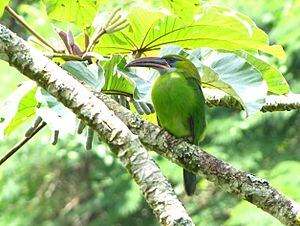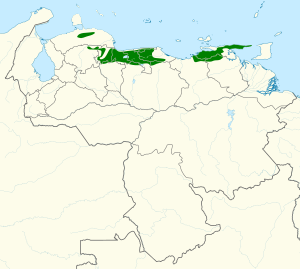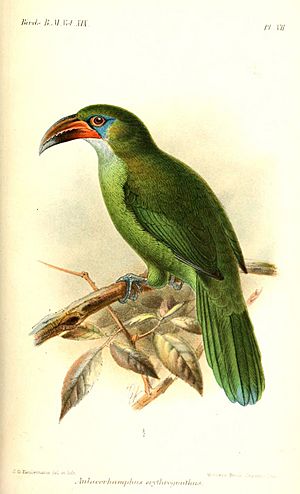Groove-billed toucanet facts for kids
Quick facts for kids Groove-billed toucanet |
|
|---|---|
 |
|
| In Henri Pittier National Park, Aragua State, Venezuela | |
| Conservation status | |
| Scientific classification | |
| Genus: |
Aulacorhynchus
|
| Species: |
sulcatus
|
| Subspecies | |
|
See text |
|
 |
|
| Synonyms | |
|
|
The groove-billed toucanet (Aulacorhynchus sulcatus) is a colorful bird from the toucan family. It lives in the forests of Colombia and Venezuela. These birds are known for their unique bills, which have special grooves.
Contents
About the Groove-billed Toucanet
The groove-billed toucanet is a type of bird in the toucan family. It was first described in 1820. Scientists group animals into different categories. This bird has three main types, called subspecies.
Toucanet Subspecies
Different groups of scientists agree on these three subspecies:
- A. s. sulcatus
- A. s. erythrognathus
- A. s. calorhynchus
One of these, A. s. calorhynchus, was once thought to be its own species. It was called the "yellow-billed toucanet." But starting in 2012, most scientists decided it was just a subspecies of the groove-billed toucanet. Some still think it should be a separate species.
Scientists are also looking at A. s. erythrognathus. Its calls sound different from the other two subspecies. This might mean it could be considered a separate species one day.
What Does a Groove-billed Toucanet Look Like?
These toucanets are about 33 to 37 centimeters (13 to 15 inches) long. They weigh between 130 and 200 grams (4.6 to 7.1 ounces). Their name comes from the grooves on their upper bill.
Bill and Body Colors
- The A. s. sulcatus and A. s. erythrognathus subspecies have bills that are mostly wine-red or brown-red. They also have a black stripe on the lower part of the bill. The A. s. sulcatus also has a white stripe at the base of its bill.
- The A. s. calorhynchus subspecies has a mostly yellow bill. It has less black and some orange-red near the base. It also has a white stripe like the A. s. sulcatus.
All subspecies are mostly green. Their undersides are lighter green. The feathers under their tail are more yellow. The A. s. sulcatus has a white throat and some gold-bronze on its face. It has blue skin around its brownish eyes. The A. s. erythrognathus looks similar but has less gold-bronze on its face. The A. s. calorhynchus is also similar but is larger than the other two.
Where Do Groove-billed Toucanets Live?
Each subspecies lives in a different area:
- A. s. sulcatus lives in northern Venezuela.
- A. s. erythrognathus lives in the mountains of northeastern Venezuela.
- A. s. calorhynchus lives in northeastern Colombia and northwestern Venezuela.
These birds mostly live in humid mountain forests. You can also find them in places with some open areas. This includes edges of forests, nearby trees, and gardens. They do not like large open spaces. They usually live between 900 and 2000 meters (3,000 to 6,600 feet) high. Sometimes, they can be found as low as sea level or as high as 2400 meters (7,900 feet).
Behavior and Life Cycle
Movement and Migration
Groove-billed toucanets usually stay in one place. They do not migrate long distances. However, during the rainy season, they might move to lower areas of their mountain homes.
What Do They Eat?
These toucanets look for food at all levels of the forest. Sometimes, they hunt in groups. They have even been seen following groups of army ants. Their exact diet is not fully known. But we know they eat both plants and animals. They enjoy fruits, insects, eggs, and small animals.
Reproduction and Nesting
Scientists do not know much about how groove-billed toucanets raise their young. Their breeding season seems to be from March to July in some areas. In northeastern Venezuela, it can last until August. In other parts of Venezuela, they might nest from February to October.
They are thought to nest in holes in trees. These holes might be natural or left behind by woodpeckers. We do not know about their nests, eggs, how long the eggs take to hatch, or when the young birds leave the nest.
Their Calls and Songs
The song of the groove-billed toucanet sounds like "barking-growling notes or croaks." It can be like "wik-wik-" or "waak-waak-." Sometimes, a male and female will sing together. Male voices are deeper than female voices. The song of A. s. erythrognathus sounds similar but is faster.
Conservation Status
The IUCN (International Union for Conservation of Nature) says the groove-billed toucanet is a species of "Least Concern." This means they are not currently in danger of disappearing. However, their total population size is unknown. Scientists believe their numbers might be going down. There are no immediate threats that have been found. More research is needed to understand their biology and how to protect them.
See also
 In Spanish: Tucancito verde para niños
In Spanish: Tucancito verde para niños




